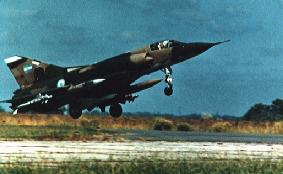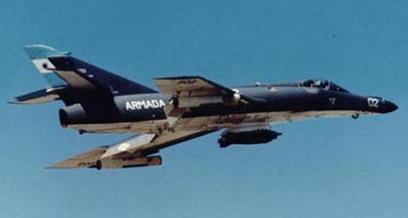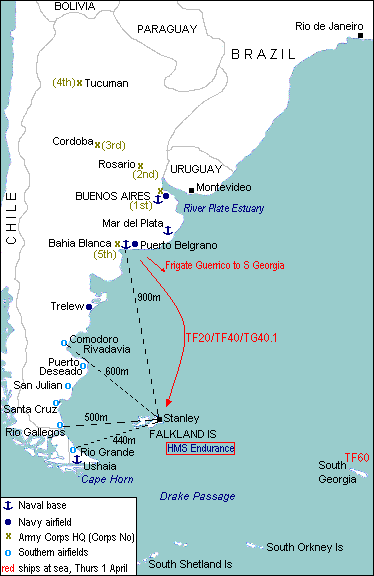Summary
of Main Argentine Naval Invasion Forces
FALKLAND ISLANDS
TASK FORCE 20 - DISTANT COVER AND SUPPORT
(Vice Admiral Juan Lombardo i/c)
CV “25 de Mayo”
(flagship)
DD “Comodoro Py”, “Hipolito Bouchard”, “Piedra Buena”,
“Segui” (all ex-US)
Tanker “Punta Medanos”
TASK FORCE 40 - AMPHIBIOUS
(Rear Admiral Jorge Gualter Allara)
DD “Santisima
Trinidad” (flagship) , “Hercules”
(both British type 42's)
FR “Drummond”, “Granville”
SS “Santa Fe”
TASK GROUP 40.1 - LANDING FORCES
(Rear Admiral of Marines Carlos Busser)
LST “Cabo San
Antonio”
Icebreaker “Almirante Irizar”
Transport “Isla de los Estados”
SOUTH GEORGIA
Icebreaker "Bahia Paraiso" became
Task Force 60
with arrival of Guerrico
First War for 100 Years - As
Argentina went to war for the first time since the Paraguayan War
of 1865-70, the Navy
and Marines would spearhead the invasion on Friday 2nd April 1982, the Army would garrison and finally lose the Falklands,
and the Air Force, which could possibly have won the coming
Anglo-Argentine war, got ready to establish a presence there.
NAVAL FORCES
Navy or Armada Republica Argentina - With a strength of 30,000 officers and men,
including 12,000 conscripts, the Navy was a mix of World War Two and
modern ships. Main units in commission were:
four patrol submarines ("SANTA
FE"
lost),
one light fleet carrier and
the old cruiser
"GENERAL BELGRANO"
(sunk),
six destroyers and three frigates, all Exocet-armed, amphibious
warfare craft,
eight fleet tankers and transports, and
two icebreakers or polar vessels,
.... a large proportion of which were at
sea on the eve of invasion.
Under the overall command
of Vice Admiral Juan Lombardo,
most sailed by Friday 26th March from the main base of
Puerto Belgrano.
Distant support and cover was
provided by Task Force 20,
... while the
landings took place from the ships of amphibious Task Force 40.
Before being recalled to join TF 40,
frigates "Drummond" and "Granville" had earlier left for South Georgia, while
fleet transport "Bahia Buen Suceso" had already returned to
Argentina from there.
Marine Corps or Infantaria de Marina
- The Navy also included a 6,000 strong Marine Corps or Infanteria de
Marina organised into two Fleet Marine forces, each with two infantry
battalions and supporting arms. It was from these, that the assault
commandos or Buzos Tactico and the landing force of some 800 men of the
2nd Marine Infantry Battalion were drawn. Another battalion was later
deployed near Stanley.
Naval Aviation Command or
Comando Aviacion Naval Argentina (CANA) - Included:
- four operational Super Etendard
strike fighters and their air-launched version of Exocet,
- eight Skyhawk A-4Q attack bombers,
- ten Aermacchi MB.339's and
- fifteen Mentor T-34C's in the light
attack role,
- Tracker anti-submarine aircraft and
Lynx, Alouette and Sea King helicopters.
Carrier "25 de Mayo" first sailed with
Skyhawks and Trackers embarked, but these were later landed, and
together with the Super-Etendards, moved to southern airfields. Flying
from there, three of the
Skyhawks were lost in combat, and of the six MB.339's and four Mentors flown to the Falklands and operated from Stanley or Pebble
Island, only one MB.339 survived.
Argentine Coastguard
or Prefectura Naval Argentina (PNA) - Separate from the Navy, the PNA operated its own
aircraft and over 40 patrol vessels. The one Puma helicopter, two Skyvan light aircraft and two patrol craft transferred to the Falklands were also lost.
| |
|
|
 |
|
 |
| |
|
|
|
Argentine Air Force Mirage |
|
Argentine Navy Super Etendard. The four
operational aircraft mounted a series of attacks on the British
Task force with Exocet missiles, sinking destroyer "Sheffield"
and aircraft/helicopter support ship "Atlantic Conveyor" |
LAND FORCES
Army or Ejercito - Although a professional army in South American
terms, a weakness in comparison with the British land forces was the
predominance of one year conscripts in the ranks. Total strength was
60,000 including 20,000 regular officers and NCO's. Organised in to five
corps, the main operational unit was the brigade of which there were
around two armoured, one mechanised, four infantry, three mountain, one
jungle and one airmobile, each consisting of three battalions plus one
artillery and one engineer battalion. In addition there were five
anti-aircraft and one aviation battalions. The Army (with the Marines)
employed on the Falklands, Panhard armoured cars, 105 and 155mm
artillery, 20mm, 30mm and 35mm AA guns, and Roland, Tigercat and
Blowpipe SAM's.
Occupation Forces
- With the islands secured by the Marines, a relatively small Army garrison was air-lifted in to
Stanley, but once the British Task Force was on its way, army strength
built-up to over 10,000 troops. Of these, a reinforced brigade
of 8,000 men from five regiments together with artillery, AA, armoured
car and engineer units stayed in the Stanley
area. Nearly 1,000 infantry with AA and some artillery went to Goose Green, and over on West Falkland, Port Howard and Fox Bay each received 800 men of an infantry regiment plus engineer
support. Many were killed or wounded and the rest captured with all their surviving equipment.
Army Aviation Command or
Comando de
Aviacion del Ejercito - Equipped with aircraft and a large variety of
helicopters, many of which were deployed to the Falklands and all lost - two Chinook CH-47C's, five Puma SA.330L's, three Agusta A-109A's and nine Iroquois UH-1H's.
AIR FORCE
Argentine Air Force or Fuerza Aerea Argentina (FAA) - According to
best estimates, the FAA started the war with:
- 45 Skyhawk A-4B and C attack
bombers,
- 37 Dagger and
- 17 Mirage fighter and attack
aircraft,
- ten Canberra light bombers,
- more than 35 Argentine-designed and
built Pucara close support aircraft,
- nine Hercules C-130 transports and
tankers,
- Learjets, Boeing 707's and a number
of other aircraft and helicopters.
Not all were operational.
As soon as the assault forces landed, the
Hercules started a job they continued to the very end; flying into Stanley the men and
materiel vital to the Argentine defence of the Falklands. Eventually
transferred to the islands were 24 Pucaras at Stanley, Goose Green or Pebble Island, and two Bell 212 and two Chinook helicopters. All but the Chinooks were
lost. As the British Task Force headed south, the FAA transferred many
of its aircraft to southern mainland bases and by the time the war was
over had lost 32 Daggers,
Mirage and Skyhawks, two Canberras, a Hercules, a
Learjet and one more Pucara.
Added to the Navy, Coast Guard and Army
casualties, Argentina lost a total of 100 aircraft and helicopters.

